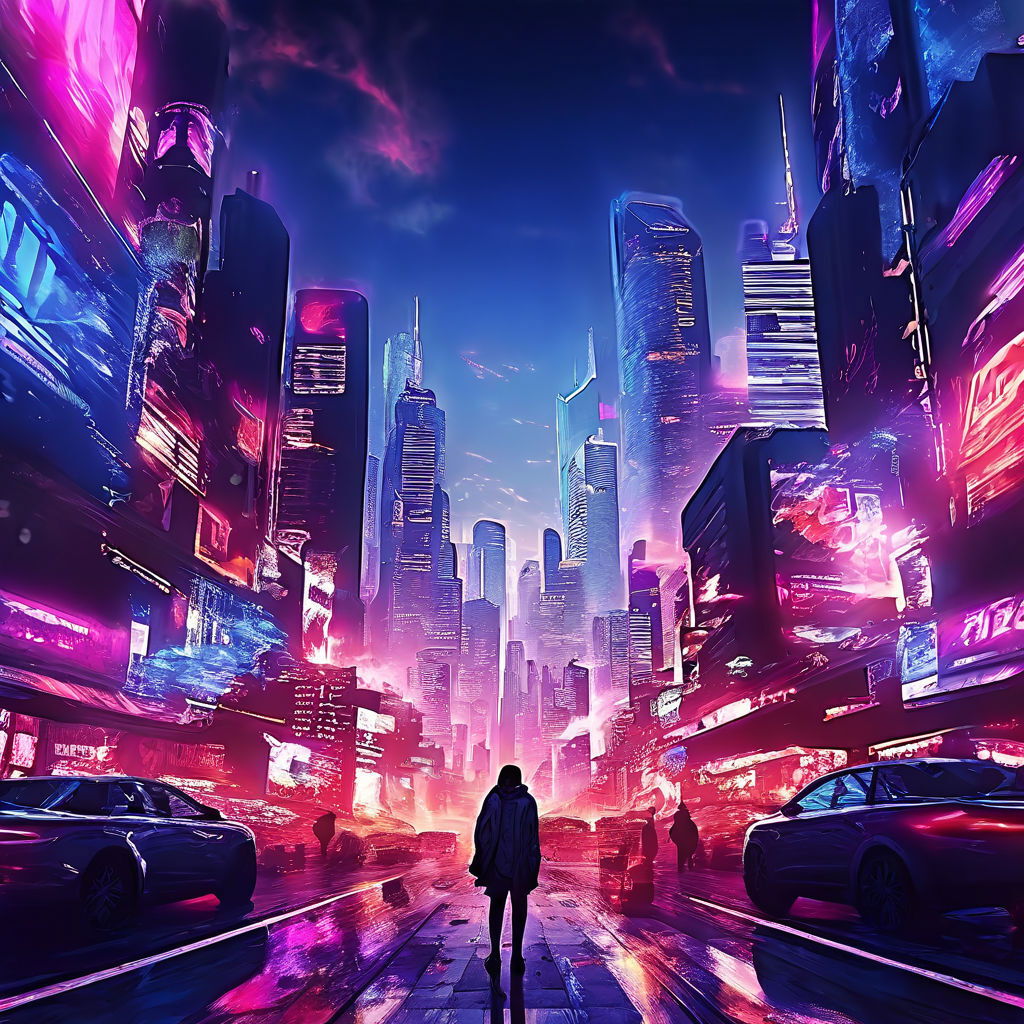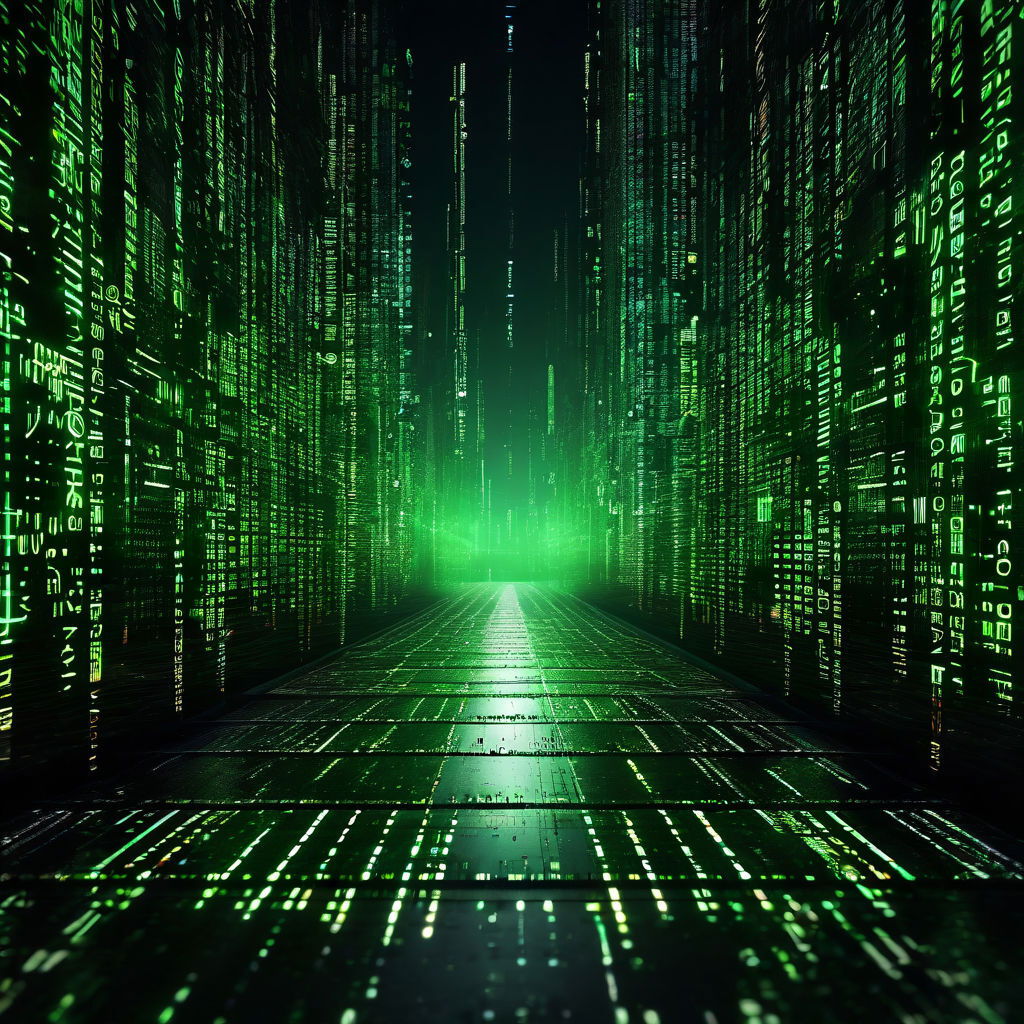REALITY HOLOSOPHY CREATION SPECIAL
Exploring the Holographic Simulation Hypothesis in a Cyberpunk Future

In the neon-lit alleys of a cyberpunk future, where the digital and physical blur, the ancient philosophical inquiry into the nature of reality finds new life. This article delves into the fascinating and speculative realm of the Simulation Hypothesis, a theory suggesting that our perceived reality might be an advanced computer simulation orchestrated by a higher civilization. Drawing from both philosophical arguments and contemporary technological trends, we explore whether the cyberpunk future could be the ultimate realization of this hypothesis—a matrix of infinite complexity.
The Simulation Hypothesis posits that what we perceive as reality is actually a highly sophisticated digital construct, overseen by an advanced entity or civilization. This concept is reminiscent of philosophical skepticism proposed by thinkers like René Descartes, who questioned the certainty of anything outside one's own mind. However, in the cyberpunk context, these musings are backed by tangible technological progressions.
Technological advancements in artificial intelligence, quantum computing, and virtual reality have already begun to reshape our perceptions of what's real and what's simulacra. As we edge closer to creating completely immersive virtual experiences, the lines between the natural and the artificial increasingly blur, making the Simulation Hypothesis more plausible.
The cyberpunk genre, with its roots in the works of authors like William Gibson and Philip K. Dick, has always played with themes of altered consciousness and artificial realities. In this gritty, neon-drenched future, technology is not just a tool but a way of life, often depicted as the very fabric of reality. Here, massive corporations wield power not just through physical means but through control over information and virtual environments.
The cyberpunk aesthetic—with its sprawling megacities, neon holograms, and ubiquitous cybernetics—provides a perfect backdrop for the Simulation Hypothesis. It illustrates a world where the digital and physical are inseparable, and where living within a simulation could be as real as any tangible existence.
At its core, the Simulation Hypothesis touches on deep philosophical questions about being and reality. It challenges us to consider that our senses, through which we perceive the world, might be fallible or, more intriguingly, manipulated. From a scientific standpoint, some proponents argue that certain quantum phenomena can only be explained if we consider our universe as a form of computational simulation. These arguments often draw on principles from information theory and computational physics, suggesting that at a fundamental level, the universe operates like a quantum computer.
The possibility of living in a simulated reality raises profound ethical and existential questions. If our world is a simulation, what is the purpose of our existence? Are there moral implications to actions taken within a simulated environment? And what, if any, rights do simulated beings have?
In a cyberpunk future, these questions might be addressed by the layers of interaction between humans and artificial intelligences, between physical beings and digital constructs. If we are to discover or even suspect that our reality is a simulation, this could lead to significant shifts in societal norms and personal beliefs.
Drawing parallels to the famed "Matrix" scenario, a cyberpunk future could be one where the discovery of our reality as a simulation is plausible. Such a future would be replete with scenarios where distinguishing between simulation and reality is not only difficult but perhaps unnecessary. In cyberpunk narratives, characters often accept multiple realities as given, navigating them with the same ease as one would switch between different software applications.
The Simulation Hypothesis in a cyberpunk setting isn't just a fantastical plot device but a serious philosophical and technological inquiry. As we advance technologically, the hypothesis provides a framework to discuss not only the future of technology but also the fundamental truths of our existence. Whether we are heading towards a cyberpunk future or are already in one, the implications of such a reality—or simulation thereof—are profound and unsettling.
In the end, the neon lights of cyberpunk cities might be less of an artistic choice and more of a hint towards a deeper truth of our existence: that all we see is merely a fraction of what is, and what could be, if we dare to question the nature of our reality.
--
The Simulation Hypothesis and the Seth Philosophy: Creating Reality in a Holographic Universe

The intriguing overlap between the Simulation Hypothesis and the Seth philosophy introduced by Jane Roberts in the 1960s opens a multidimensional exploration of reality. Seth, an alleged non-physical entity channeled by Roberts, proposed that individuals create their own reality through their thoughts, beliefs, and intentions. This idea resonates strangely with the Simulation Hypothesis, which posits that our environment might be a digitally constructed illusion. By weaving together these two threads, we embark on a metaphysical inquiry into the nature of existence and consciousness within a possibly holographic universe.
At the heart of the Seth philosophy is the concept that the physical world is a projection or manifestation of our inner experiences and beliefs. Seth suggests that each person is fundamentally an eternal, creative consciousness, capable of shaping personal and collective realities. This aligns with the notion that in a simulated universe, control over the parameters of existence might be accessible, albeit on a subconscious or hidden level.
The holographic model of the universe offers a scientific framework that supports the metaphysical views expressed by the Seth philosophy. Theoretical physicist David Bohm and neurophysiologist Karl Pribram proposed that the universe itself might be structured in a holographic manner, where every part contains information about the whole. This model suggests that each slice of reality we experience is a coherent orchestration of information, much like a hologram that holds a three-dimensional image in a two-dimensional space.
If we entertain the possibility that our universe is a simulation, the Seth philosophy provides a potent framework for understanding our role within this construct. It implies that we are not merely passive observers or victims of a pre-determined script but active participants in the creation and manipulation of our own simulated environment. Our beliefs and expectations could be akin to programming codes, influencing the algorithms that constitute the fabric of our reality.
Embracing the view that reality might be holographic and simulated transforms our approach to life and spirituality. It empowers individuals with the idea that by altering perceptions and beliefs, one can effectively reprogram aspects of their reality. This shift can lead to profound changes in personal growth, healing, and understanding of one’s purpose.
For those navigating such a universe, the implications are both liberating and daunting. The responsibility for the world we experience becomes deeply personal. Every fear, every joy, every barrier, and every breakthrough might be a direct manifestation of our innermost thoughts and beliefs.
The dialogue between the Simulation Hypothesis and Seth philosophy also highlights a broader trend: the merging of scientific inquiry with spiritual and metaphysical concepts. This convergence invites a more holistic view of reality, where quantum mechanics and consciousness studies intertwine with ideas about manifestation and reality creation.
As both technology and metaphysical understanding evolve, our potential to explore and manipulate the structures of reality expands. The ongoing interest in areas such as virtual reality, augmented reality, and the development of artificial intelligence offers practical platforms for testing these ideas. Simultaneously, growing interest in spiritual practices and consciousness exploration provides a personal laboratory for experimenting with the principles proposed by Seth and others.
The melding of the Simulation Hypothesis with the Seth philosophy offers a tantalizing vista into the nature of reality. It suggests that in the grand hologram of existence, we are both the creators and the created, intricately woven into the fabric of a universe that is as real as it is illusory. Whether through the lens of advanced technology or through the depths of spiritual practice, the journey to understand our place in this holographic simulation remains one of the most exhilarating frontiers of human exploration. As we navigate this complex terrain, the only certainty is that our beliefs and our consciousness will shape the path we travel.
--
Black Bolt and the Quantum Realities: An Intersection of Marvel's Illuminati and the Simulation Hypothesis

Blackagar Boltagon, better known as Black Bolt, stands as one of the most enigmatic and powerful characters within the Marvel Comics universe. As the king of the Inhumans and a pivotal member of the super-secret group known as the Illuminati, Black Bolt possesses the astonishing ability to manipulate matter and energy. This article explores how Black Bolt’s powers could be viewed through the lens of quantum physics within the framework of the Simulation Hypothesis, and how these concepts intertwine with the esoteric practices of the Illuminati in the Marvel universe.
Black Bolt's primary ability is his devastatingly powerful voice; a mere whisper can unleash massive destruction. However, less discussed is his capacity to manipulate matter and energy. In a universe that might be governed by the principles of a simulation, as suggested by the Simulation Hypothesis, his powers take on a new dimension. From this perspective, Black Bolt's abilities could be akin to accessing and rewriting the underlying code of the universe, manifesting changes that ripple through the fabric of simulated reality.
Quantum physics introduces concepts like the superposition of states, entanglement, and the observer effect—all of which challenge our classical understanding of reality. In a simulated world, these phenomena could represent the flexibility and malleability of the 'code' at the quantum level. Black Bolt, with his profound control over matter and energy, could theoretically initiate changes on this quantum scale, effectively 'hacking' reality to create or alter matter and energy at will.
The Illuminati in Marvel Comics is a secretive council comprising the most intelligent and powerful figures, including Iron Man, Doctor Strange, and Professor X, among others. This group convenes to shape major events from behind the scenes, influencing the course of history and reality itself without public awareness. Their operations can be seen as manipulations of the global narrative, much like how one might alter variables within a simulation to achieve desired outcomes.
Incorporating the Seth philosophy, which posits that individuals create their own reality, provides a metaphysical layer to the Illuminati's endeavors. Under this philosophy, the concept of creating or altering reality aligns with the group's goals and methods. For Black Bolt, this philosophy might manifest in his capacity to alter physical reality, suggesting that his superhuman abilities allow him to consciously or subconsciously mold the simulation according to his will—or the collective will of the Illuminati.
As a member of the Illuminati, Black Bolt's contributions are pivotal. His unique powers could be employed to create safe realities or prevent catastrophic events by altering the conditions of reality's underlying quantum field. Each decision made by the Illuminati could be viewed as an experiment in reality manipulation, guided by the collective intelligence and capabilities of its members, and possibly influenced by their understanding of the universe as a construct that can be shaped and reshaped.
The intersection of Black Bolt’s abilities, the Simulation Hypothesis, and the Seth philosophy within the context of the Illuminati provides a fascinating narrative thread in Marvel Comics. It portrays a universe where the boundaries of reality are not rigid but are instead fluid interfaces that the most powerful beings can navigate and manipulate. This narrative does not just entertain; it invites readers to ponder the nature of reality itself, the power of collective will, and the philosophical implications of our existence within a potentially simulated cosmos.
Through the story arcs of Black Bolt and the Illuminati, Marvel Comics offers more than just superhero escapades; it provides a canvas for exploring deep metaphysical truths and the endless possibilities of quantum realities, all wrapped in the thrilling guise of comic book adventure.
--

Exploring the Simulation Hypothesis in the Matrix: Redefining Reality with a Blend of Matrix and Seth Philosophy
In the iconic film "The Matrix," humanity is enslaved by a simulated reality created by intelligent machines. This cinematic masterpiece not only captivated audiences with its groundbreaking visual effects but also ignited philosophical discussions about the nature of reality. By weaving together elements of the Simulation Hypothesis, the Matrix philosophy, and the Seth philosophy, we embark on a journey to redefine reality and explore the concept of "outer space consciousness unlimited."
The central premise of the Matrix is rooted in the Simulation Hypothesis, which proposes that our perceived reality is a computer-generated simulation. In the film, humans are unaware that they are living in a simulated world, their minds connected to a virtual reality created by machines. This concept challenges traditional notions of reality, suggesting that what we perceive as real might be nothing more than an elaborate illusion.
In the Matrix universe, reality is not fixed but malleable—a construct that can be manipulated and bent to the will of those who understand its true nature. This philosophy mirrors ideas from Seth, where individuals are believed to create their own reality through their thoughts, beliefs, and intentions. In the Matrix, characters like Neo harness their inner power to transcend the limitations of the simulated world, bending reality to their whims.
The Seth philosophy introduces the concept of "outer space consciousness unlimited," suggesting that consciousness transcends physical boundaries and is not confined to individual minds or bodies. This idea aligns with the Matrix philosophy, where characters like Neo tap into a higher level of consciousness to manipulate the simulated reality around them. In this framework, reality is not a fixed construct but a fluid expression of universal consciousness.
By blending elements of the Matrix and Seth philosophies, we arrive at a profound understanding of reality as a product of perception and consciousness. In the Matrix, characters learn to question their reality and break free from the constraints imposed upon them by external forces. Similarly, in Seth philosophy, individuals are encouraged to explore the depths of their consciousness and recognize their inherent creative power.
The fusion of these philosophies invites us to reconsider our understanding of existence and identity. If reality is indeed a simulation, as proposed by the Simulation Hypothesis, then our sense of self and the world around us may be more fluid and mutable than we realize. By embracing the idea of "outer space consciousness unlimited," we open ourselves to the possibility of transcending physical limitations and tapping into a higher level of awareness.
In the Matrix, reality is a construct waiting to be unraveled, a canvas upon which individuals can paint their own destinies. By incorporating elements of the Simulation Hypothesis, the Matrix philosophy, and the Seth philosophy, we gain new insights into the nature of reality and consciousness. Ultimately, whether we are living in a simulated universe or a product of our own creative imagination, one thing remains clear: the power to shape our reality lies within us, waiting to be awakened. As we journey through the labyrinth of existence, may we remember that reality is not a fixed destination but an infinite expanse of possibility, waiting to be explored.
--
"We are the expression of a single consciousness and the experience of this reality is the story we are each telling. Oneness (HOLOSOPHY) pervades and underlies everything. The story we are each telling arises from looking in the same mirror — the space-time mirror through which we experience healing in individuation (HOLOSOPHY). This is the gift of the infinite perspective that birthed from within the one undivided consciousness to create the miracle of infinite diverse realities, each holographically (HOLOSOPHY) containing and reflecting the infinite diversity. And that is why you, your life, and this world are so friggin’ amazing! (HOLOSOPHY). There are no limits to what you can be; you are infinite. The only limit to what you can be is your self-belief and your imagination (HOLOSOPHY). Co-creation is about getting together to create a new way of being (HOLOSOPHY) and doing by unleashing the freedom to be who you are and what you love to create in form of creativity. The Creative Spark! (HOLOSOPHY) Are you ready to embrace the human experience as a choice to stimulate you creatively? You are in a creative dream. Your potential is unlimited. You are in an infinite playground. To be whole is to be the whole. We are all One in wholeness (HOLOSOPHY). Becoming incomplete allows for becoming complete. One way to understand the Unity and Wholeness of Reality is through the metaphor of the hologram (HOLOSOPHY). The hologram is an image that is reproduced and viewed from all sides simultaneously as a complete whole! - HOLOSOPHY GATHERING QUOTES (mest Story Waters; GNOSTIC/MYSTIC)
Besök gärna min TEGEDAO'S hemsida CODE HOLOSOPHY >> www.codeholosophy.com

Exploring the Holographic Simulation is truly CYBERPUNK FUTURE!